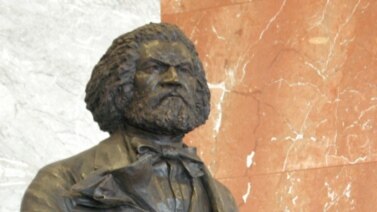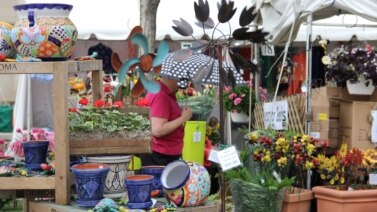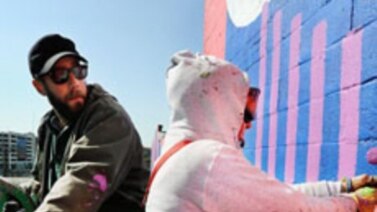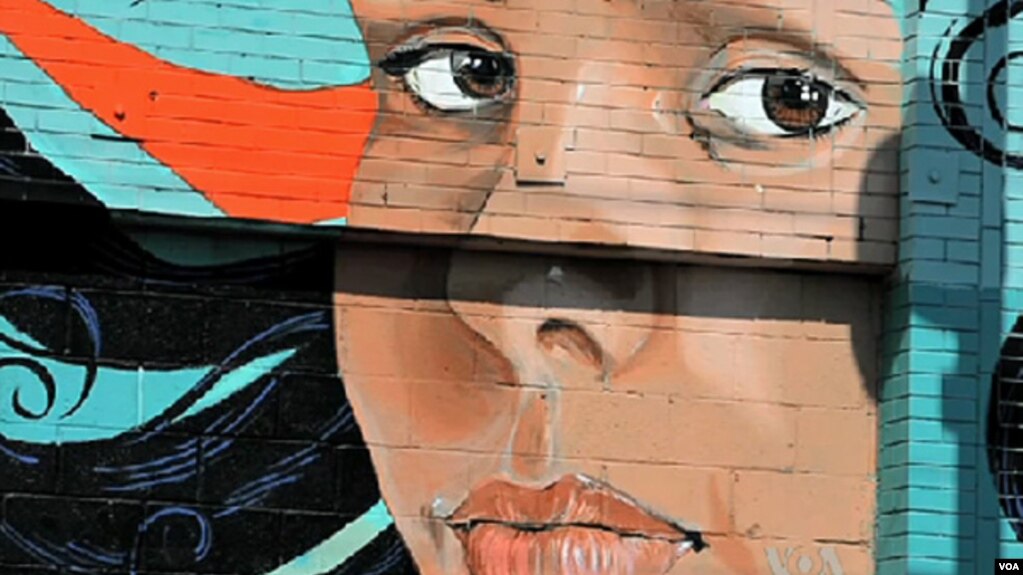
Welcome to American Mosaic from VOA Learning English.
I’m June Simms.
On the show today, we play new music from country star Keith Urban.
We also roll down some old train tracks in Missouri.
But first, we go to the west coast to look at some big art in the city of Los Angeles.
(MUSIC)
LA Murals
The city of Los Angeles, California is famous for its murals – artwork covering the sides of buildings and bridges over busy roads. Katherine Cole tells us how the murals add color and character to the city.
Many drivers pass by a huge mural of the Los Angeles Chamber Orchestra every day as they go to and from work. It is easily seen from a major freeway near the city center. The massive work includes images of the orchestra’s violin, oboe and viola players.
Kent Twitchell created the painting in 1991. He has also made many others in the city. A piece painted in 1971 remains on the wall of a house a short distance from the center of Los Angeles.
“I decided to paint my favorite actor, Steve McQueen. I didn’t fancy myself as being some heavy-duty modernist artist. I just painted what felt good to me.”
Photographs of that Steve McQueen mural made Kent Twitchell famous. His other works include a work in honor of the 1984 Los Angeles Olympics and paintings of America’s founding fathers. Some important murals, however, have been painted over or damaged by graffiti.
“I was so naïve. I thought I was living in Florence and that people would just appreciate and love it. But that didn’t turn out to be the case in many instances, and a lot of the great L.A. murals are gone now.”
Some historic art in Los Angeles has been repaired. Leslie Rainer is with the Getty Conservation Institute. She says experts carefully repaired a mural from 1932 by visiting Mexican artist David Alfaro Siqueiros.
“He painted this very controversial image of a crucified central figure with an eagle looming above him, and some revolutionaries aiming their rifles at the eagle.”
She says the message of the painting is not entirely clear. The eagle could represent the United States or Mexico. Each country has chosen the bird as its national symbol. But the image offended city leaders. They ordered it painted over. Experts finished restoring it in 2012.
Artist Lydia Emily shares a social message with her wall art. She tells the story of a young woman named Jessica in one of her murals. Jessica is a victim of the sex trade. The work shows her face and a bird that represents freedom, says the artist.
“I did an interview with Jessica where I learned her entire story, how she was kidnapped, how she was sexually trafficked for her whole life, how she was rescued, how she became who she is today. And then I tried to paint the narrative.”
Lydia Emily also painted a mural in the homeless neighborhood known as Skid Row. It shows an African woman of the Masai tribe and the native birds of Kenya. She says it represents the difficult life of the world’s native peoples. Los Angeles officials were once hostile to murals and other street art. Now they are providing strong support, as long as the owner of the property gives permission. Officials recently eased rules about street murals in an effort to get more art and color in the city.
Parks by Rails to Trails
Railroads once crossed the United States in every direction. Trains carried the goods that kept the economy growing. Today, the railroad system is still an important part of the nation’s transportation system but it plays a much smaller part than it once did.
Thousands of kilometers of train tracks are no longer in use. A group called “Rails to Trails” has turned many of these old tracks into parks for walking, running, biking and other activities. One such lengthy park extends for many kilometers in the state of Missouri.
The morning sun shines like gold on the two rails of a train track that extends through Sedalia, Missouri. A car rolls over the tracks, and then disappears up the street. No train comes down the track until a ringing gate drops down to let one engine through. It pulls a single train car.
More than 30 people stand several streets away. They are all wearing bicycling clothes. The group is looking up a large building that looks like a palace. It formerly served as the Sedalia train station and now is home to the city’s train museum.
Kathleen Boswell is a museum tour guide. She says the structure dates back to the 1860s when trains ruled transportation in America.
“Well, there used to be about a dozen train tracks, both sides of the building. And we have only this one little piece left now.”
Hundreds of trains a week stopped at this station. By the 1970s, trucks and airplanes were the main carriers of goods and people. The train tracks were no longer being used. Years later, private donors and government officials worked together to turn the area into an attraction for visitors.
“This is our 22nd year for the Katy Trail, for bicycles.”
The former Katy railway was named for the MK&T line. Its trains served Missouri, Kansas and Texas.
A group of people now jump on bicycles and test their pedals. They are getting ready for a week of biking 50 to 80 kilometers each day. A tour guide points them toward the city of St. Louis, Missouri.
“Which direction are we going?”
“We’re going east, all the way.”
“Which way is east?”
“Follow the sun…”
Soon the cyclists are riding along the car-free path through forests and tunnels, past cornfields and along the wide Missouri River. Almost a half-million people take trips on the Katy Trail every year. Over 20,000 of them come from outside of Missouri. Cyclist Stacy Heikes lives in Colorado.
“Yeah, I love biking. I love biking. That’s why I’m here. But, I love biking in new places so you can see new stuff, you’re not looking at your same old path every time. You’re looking at something new. Right up the road, we hear, there is a burr oak (tree) that’s the state champion burr oak in size.”
A tour agency called Road Scholars organized this group’s trip. It urges cyclists to make side trips to train museums, wine grape farms and the state capital along the way. Californian native Alice Frost says the historic wall paintings at the capitol building in Jefferson City captured her heart.
“The one mural in the senator lounge was just magnificent. I had never been to Missouri before and I sort of put it on my low list of places I might like to go. But after seeing it, I see it has many things here that are very good…for vacationing and I’m enjoying it.”
The 390 kilometer long Katy Trail cost six million dollars to build. Today, the state of Missouri spends only a small percentage of that amount each year to keep the trail in good condition.
Todd White is owner of Katy Bike Rental in the town of Defiance. He praises the decision to set up the trail.
“The economic impact study says 18 and a half million dollars every year is getting sprinkled along this trail. 250 thousand meals, and of course, the bike shops and different support services along the trail as well.”
Mr. White adds that many Missouri cities now require major roads and bridges to include a bicycle path. He says neighborhoods are also building bike paths to link to the Katy Trail.
(MUSIC)
Keith Urban “Fuse”
It has been three years since country music star Keith Urban released a studio album. The singer from New Zealand used that time to create a collection of songs that he describes as “liberating.” Mario Ritter plays some for us.
(MUSIC)
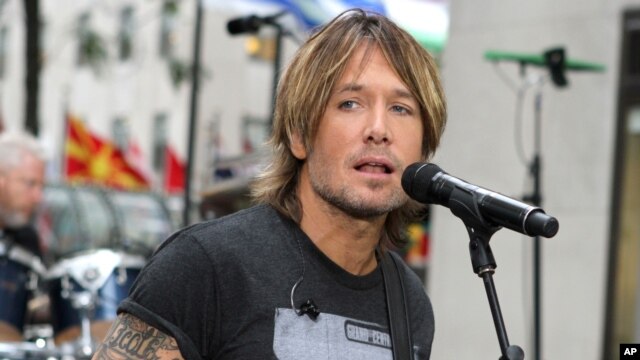
“Little Bit of Everything” was Keith Urban’s first single from his new album, “Fuse.” The song became his fourteenth number one hit on the country charts. The album also entered Billboard Magazine’s Top 200 Albums chart at number one.
Urban experimented with different sounds on “Fuse,” and worked with nine producers from the R&B and rock worlds. Urban says that experimentation was what led him to name the album “Fuse.”
“It started with just trying to bring things together -- instruments, sounds, rhythms, and so forth -- to fuse things together that I hadn’t done before, to this degree.”
(MUSIC)
Urban says working with others is his favorite part of making an album. He says his goal for “Fuse” was to bring a new energy to his sound. Urban performs on the album with other country singers, including Miranda Lambert and Eric Church.
“Eric I’ve known for a couple of years and I came upon this song called ‘Raise ‘Em Up.’ It was just a perfect song for us, and I’m really glad that he wanted to be on the record. And then Miranda opened some shows for us many years ago. And you know, we used to sing together at the end of the night and I always loved the way our voices sounded together. So, in the back of my mind, I’ve always had a hope that I could find a song one day that we could do and this song called ‘We Were Us’ came along. It was just the right song at the right time.”
His duet with Miranda Lambert entered Billboard Magazine’s Top 20 Country Airplay Chart just three weeks after it was released. That makes it one of the fastest-climbing songs of his career.
(MUSIC)
I’m June Simms. Our program was written and produced by Caty Weaver. Join us again next week for music and more on American Mosaic from VOA Learning English.
(MUSIC)
